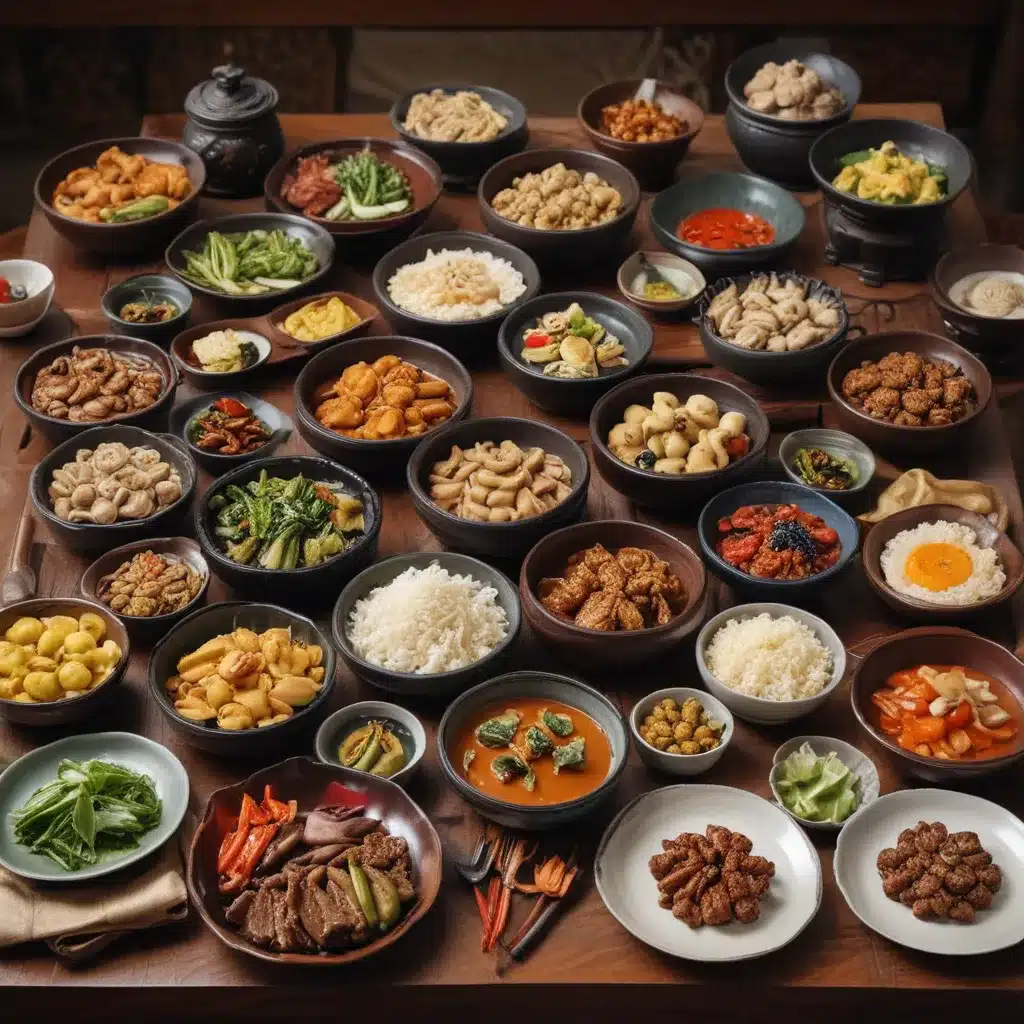
Uncovering the Secrets of Korea’s Contemplative Culinary Tradition
As I step into the serene sanctuary of a Korean Buddhist temple, the aroma of simmering herbs and fragrant spices wafts through the air, beckoning me to explore the hidden wonders of Korean temple cuisine. This ancient culinary tradition, rooted in the principles of Zen Buddhism, is a captivating blend of culinary artistry, spiritual nourishment, and a deeper connection with the natural world.
Embracing the Essence of Mindfulness
At the heart of Korean temple cuisine lies the concept of ‘Baru Gongyang,’ which translates to “eating with a mind of reverence.” This philosophy encourages practitioners to approach mealtime as a meditative practice, where every bite is savored with a deep appreciation for the ingredients, the preparation, and the interconnectedness of all things. As I sit down to a traditional temple meal, I can almost feel the weight of my everyday worries lifting, replaced by a sense of calm and presence.
The chefs, or Seunim, who prepare these meals, are not mere cooks, but rather, they are guardians of a sacred culinary tradition. They approach their craft with a reverence akin to that of a Zen monk, imbuing each dish with layers of symbolism and spiritual significance. From the selection of locally-sourced, seasonal ingredients to the meticulous techniques used in their preparation, every aspect of the process is infused with a deep respect for the natural world and a desire to nourish both the body and the soul.
Exploring the Principles of Temple Cuisine
One of the foundational principles of Korean temple cuisine is the emphasis on ‘Baru,’ which translates to “the pure.” This principle guides the chefs to utilize only the freshest, most wholesome ingredients, often sourced from the temple’s own organic gardens or from local, sustainable producers. The absence of meat, dairy, and strong-flavored seasonings is not merely a dietary restriction, but rather, a conscious choice to create a culinary experience that is in harmony with the principles of non-violence and mindfulness that are central to Zen Buddhism.
Another key aspect of temple cuisine is the concept of ‘Bongseon,’ which refers to the harmonious balance of colors, textures, and flavors within a single dish. The chefs carefully curate each plate, ensuring that the flavors and visual elements complement one another, creating a sensory experience that is both aesthetically pleasing and deeply satisfying.
Savoring the Subtle Flavors of Temple Cuisine
As I take my first bite of a temple-style vegetable stew, I am immediately struck by the depth and complexity of the flavors. The earthy notes of the mushrooms, the gentle sweetness of the carrots, and the subtle umami of the soy-based broth mingle together in a symphony of taste. Unlike the bold, assertive flavors often associated with Korean cuisine, temple dishes are characterized by a delicate balance, where each ingredient is allowed to shine without overpowering the others.
One of the hallmarks of temple cuisine is the use of ‘Jang,’ a collection of fermented sauces and pastes that serve as the foundation for many dishes. These complex, flavor-packed condiments are the result of meticulous preparation and months of careful fermentation, imbuing the dishes with a unique depth of flavor that is both comforting and intriguing.
Uncovering the Spiritual Significance of Temple Cuisine
As I delve deeper into the world of Korean temple cuisine, I begin to uncover the intricate web of spiritual symbolism that is woven into every aspect of the culinary experience. The dishes themselves are often designed to represent the principles of Zen Buddhism, with each ingredient and preparation method carrying a deeper meaning.
For instance, the traditional ‘Sujebi’ dish, a hand-torn noodle soup, is said to represent the concept of ‘Tathata,’ or the idea that all things are inherently perfect and complete. The act of tearing the noodles by hand, rather than cutting them, is a symbolic gesture of accepting the world as it is, without the need for imposed perfection.
Similarly, the use of ‘Sang-jeok’ in temple cuisine – a delicate, leaf-wrapped rice cake – is believed to symbolize the idea of ‘Shuni,’ or the interconnectedness of all things. The leaves, which are carefully selected and prepared, serve as a physical representation of the intricate web of life that sustains us all.
Experiencing the Zen of Temple Cuisine
As I savor the final bites of my temple-style meal, I can’t help but feel a deep sense of calm and contentment wash over me. The experience has been not just a culinary one, but a profound exploration of the Zen philosophy that underpins this ancient tradition.
In a world that often prizes speed and efficiency, Korean temple cuisine serves as a reminder to slow down, to savor the moment, and to find joy in the simple pleasures of life. It is a testament to the power of mindfulness, and a celebration of the deep connections between food, spirituality, and our shared humanity.
So, if you’re ever in the Boston area and looking to embark on a journey of culinary and spiritual discovery, be sure to explore the rich tapestry of Korean temple cuisine. Who knows, you might just leave with a new appreciation for the beauty of the present moment, and a belly full of delicious, soul-nourishing food.
And if you’re interested in experiencing the wonders of Korean cuisine firsthand, I highly recommend visiting Korean Garden Boston. Their team of dedicated chefs and servers are passionate about sharing the rich cultural heritage of Korean food, so you’re sure to have an unforgettable dining experience.
